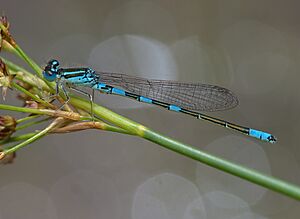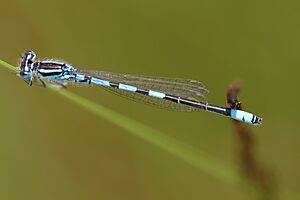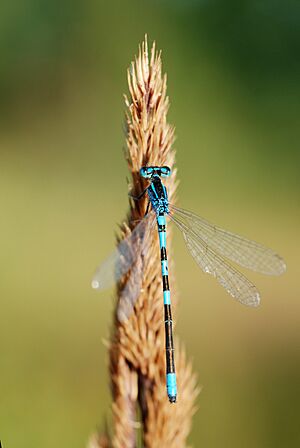Dainty damselfly facts for kids
Quick facts for kids Dainty damselfly |
|
|---|---|
 |
|
| Conservation status | |
| Scientific classification |
The dainty damselfly (Coenagrion scitulum) is a small, blue insect. It is also called the dainty bluet. This damselfly belongs to the Coenagrionidae family. You can mostly find them in southern Europe, northern Africa, and parts of Asia and Central America.
Dainty damselflies are hunters, just like dragonflies. They can grow to be about 30–33 mm long. Their back wings are usually 15–20 mm long. Males and females look a bit different. Males have a blue section on their body (segment eight) with black marks on the next part (segment nine). Females are mostly black near their tail with smaller blue spots. Even though they are easy to tell apart, they can sometimes be confused with the common blue damselfly.
Contents
Where Dainty Damselflies Live
Dainty damselflies like to live near large, still ponds. These ponds usually have lots of plants like water-milfoil and hornwort. You might also find them in flooded ditches.
They also like special areas called constructed wetlands. These places are great for them because there are usually no fish. Fish often eat insects, so these wetlands give the damselflies a safe place to live and have their babies.
You can spot dainty damselflies most easily in June and July. Males often sit on plants floating on the water. Even though they are small, they can fly to different ponds if they need more food or a better home. We know this because they came back to Britain after disappearing for many years.
How Dainty Damselflies Reproduce
Dainty damselflies have interesting ways of mating. Like other Odonates (dragonflies and damselflies), they have a special way to pass on genetic material during reproduction. The male holds the female behind her head with special claspers. The female then bends her body to connect with the male's underside. This forms a "heart" or "wheel" shape. After mating, the female lays her eggs, often in water plants.
Protecting Dainty Damselflies
The dainty damselfly used to live and breed in Britain. But after a big flood in the North Sea in 1953, people thought they had disappeared from the area. There was a large group of them in East Anglia. After the flood, no one saw them for many years. Everyone thought they were gone.
Then, in 2010, after 57 years, dainty damselflies were found again in Kent! This meant a small group must have survived all along. It's also possible that damselflies from a nearby area flew back to Britain. Dainty damselflies can fly quite far.
Today, the IUCN Red List says the dainty damselfly is a 'Least Concern' species. This means their population is stable and not in danger, according to the IUCN.
Where Dainty Damselflies Are Found
Where They Live
Dainty damselflies are mostly found in western Europe, northwest Africa, and parts of Asia. You can also find them in Eastern Europe. There might be another group of them in central Asia. Scientists are not sure if these are a different kind of damselfly or if they flew there from Europe.
How They Move Around
Many things make dainty damselflies move to new places. These include warmer temperatures, changes to the land, and less water. The main reason they move is because of rising temperatures. They try to find new places that have the perfect warm weather for them.
In the 1990s, the farthest north they lived was in northern France. But because of climate change, they have been moving more and more towards the north, east, and west. They are now living in new areas they didn't use to call home.
When they move to new places, the groups of damselflies can change. For example, the new groups might have less variety in their genes. This can make them less strong against stress or diseases. It can also make them more sensitive to things like pesticides. Pesticides can make it harder for them to move, grow, and fly. As they spread out, dainty damselflies often have to fly over farms where pesticides are used.
It's not just climate change that causes these genetic changes. It can also happen when they naturally spread out to new areas. The way dainty damselflies are built and how their genes are arranged is shaped by both their past movements and current things like the environment.
Images for kids






